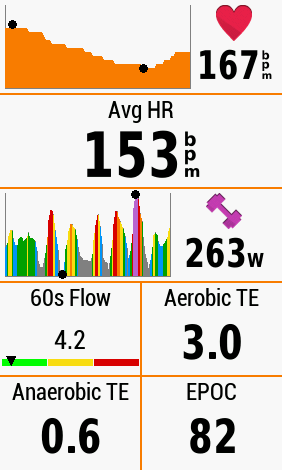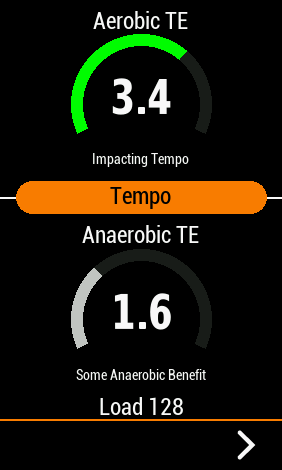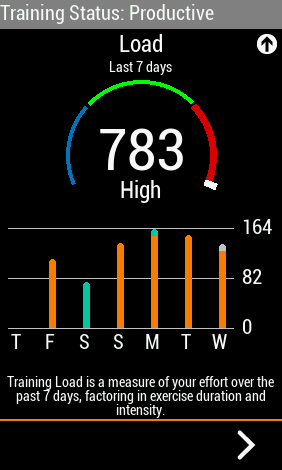EPOC, Aerobic TE and Anaerobic TE Are Great Fields to Help Measure Fitness

I’ve been using Garmin products since the early 2000’s. I love their adaptability, and their thorough approach to displays. Riders and runners love to complain about Garmin setup and use, but no other product is as complete or has so many features. EPOC is a cost-effective way to measure fitness and the results of a ride.
On July 1st, 2020, Garmin announced that they had purchased FirstBeat Technologies. This REALLY excited me, because I have studied FirstBeat since at least 2003. FirstBeat is a Finnish Company that has studied Heart Rate Variability (HRV), and how that applies to fitness. I’m currently working on HRV software through www.fitnesshrv.com, but that product is mostly designed around indoor use. For Cyclists, Runners and Swimmers who own Garmin head units and watches, we can use FirstBeat technology to gain insights into just how a ride is improving your fitness.
EPOC (Excess Post-Exercise Oxygen Consumption)
I first began studying EPOC in the mid 2000’s, when it was incorporated into the Suunto T6 fitness watch. I LOVED helping people in SPIN classes, who did not have access to wattage at the time, work on improving their fitness with this device. PUBLISHED SCIENCE shows that EPOC can help exercisers measure their efforts smarter. The TL:DR goes like this:
- When you exercise, you stress the body.
- The Frequency, Intensity, and Duration of the Stress (FIT) affects your heart, heart rate, and heart rate variability.
- This stress leads to EPOC.
- Garmin’s Training Load value serves as a “Score” for EPOC.
- This Score can be used to modulate training. The Score also breaks down into Aerobic Training Effect and Anaerobic Training Effect.
Here’s a great link to a video that can further explain what’s going on.
EPOC Scores Lead to Aerobic TE and Anaerobic TE
In my zeal to measure all things PHYSICAL, I migrated from EPOC and Training Effect over the years, to wattage. But recently, I’ve been mountain biking a lot more, and I’m using EPOC with every ride. One of the most important aspects of all endurance exercise is finding the right balance between Aerobic Training Effect, Anaerobic Training Effect, and overall Volume. We don’t want to do too much, too often, but we do want to Progress and Periodize with the seasons.
FirstBeat defines Training Effect like this:
Training Effect (TE) represents the degree of homeostasis disturbance resulting from a session of physical activity. The Training Effect is based principally on EPOC values during exercise, which is further scaled based on the individuals fitness or activity level. The higher the TE-value the higher is also the expected increase in maximal performance after the exercise. EPOC (and TE) gets higher when either exercise intensity or duration is increased.
Training Effect describes the effect of exercise on a 0-5 scale:
0.0 – 0.9 = no effect
1.0 – 1.9 = minor effect (recovery training)
2.0 – 2.9 = maintaining effect
3.0 – 3.9 = improving effect
4.0 – 4.9 = highly improving effect
5.0 = temporarily overreaching effect
It is important to remember that a high TE is not needed in every exercise – for example doing an fitness-improving exercise session (TE e.g. 3.0) at least once a week combined with two weekly maintaining exercise sessions (TE e.g. 2.0) is enough to maintain (in trained individuals) or even improve (in sedentary individuals) the person’s aerobic fitness.
Every ride and every run will yield not just an EPOC value, but also an AEROBIC Training Effect, and an ANAEROBIC Training Effect. If you’re a mountain biker, wattage tends to be incredibly stochastic, and can be hard to interpret. Instead, if you follow my lead and add those fields to a profile page on your Garmin head unit or watch, you can observe and measure Training Effect instead!
EPOC becomes Training Load in Garmin Connect
If you own a Garmin Fitness device, you probably have a Garmin Connect account. Garmin Connect is FULL of great information! However, getting to the areas where you can assess fitness and start to understand how your training is affecting your performance, can be a little hard to find.
Try this:
- Enter your username and password into Garmin Connect and go to the main page. It should look something like this:

- Now move your mouse to the area on the left titled “REPORTS”.
Click on “Cycling”, and “Training Status”. That SHOULD bring you to a page that looks something like this:

- Let’s start at the “STATUS” area of Yellow, Orange, and Green blocks. Mousing over the blocks shows you whether the day’s work was ‘Productive’ (Green), ‘Unproductive’ (Orange), or ‘Maintaining’ (Yellow). Purple is ‘Peaking’, and black means you’re in a state of ‘Detraining’.
- The next graph shows ‘Vo2 max’. Now, this is important. This is an ESTIMATION of Vo2. It is NOT ALWAYS all that accurate. I’ve had it be SPOT-ON, and I’ve had it be off by as much as 5 points. I’m not going to argue the merits of the claim here, but the important thing to focus on is whether that value is IMPROVING or not, and if not, why. Here’s a video link showing a man and a woman performing Vo2 max tests in a lab, and comparing those values to the Garmin Firstbeat data. The important thing to remember is that the Vo2max values are a FEATURE that comes from EPOC and Training Effect.
Next, let’s look at Exercise Load.

Now, look at the colors, as well as the scale for this chart. It’s revealing our DAILY EPOC value from rides, as well as the Training Effect Breakdown. Most of my recent rides have been aerobic in nature, as I regain some fitness after a haywire heart concern that affected my ability to recover and sleep. If you look about five rides back from the right, you’ll see a bar that is both Orange and Purple. That was a High Intensity day, with an EPOC near 130. This is what the summary looked like on the Garmin head unit, after the ride.

Finally, and perhaps most importantly, take a look at the graph on the page that shows 7-day Training Load.

When you’re cycling through a post-ride summary, the Training Load value looks like this on your Garmin head unit.

Training Effect and EPOC recommendations
The Published Science on FirstBeat’s claims shows that the values can guide users to greater gains, without further investments in expensive products. Let’s face it – these products are never cheap, and there’s always a push for more hardware integration. We can achieve this with Garmin’s NIRS technology, as well as their chest straps. The accuracy may not be as precise as a watt-meter, but it may not always be necessary to measure every Newton-Meter or KiloJoule, etc.
In general terms, try this:
- BE CONSISTENT. Ride, run, or swim for an EPOC of between 100 and 150 points. Use those numbers for a few weeks, and then compare them to the SUGGESTIONS on the Garmin Connect 7-day Training Load chart.
- VARY your Aerobic Training Effect and Anaerobic Training Effect. There ARE SUGGESTIONS for these values as well. There’s a hidden page that can show your Load Focus as it compares to the ‘Optimal Range’ Recommendations. I have been riding between a 3.0 and a 4.0 on the Aerobic Training Effect, and a 0 to 2.0 on the Anaerobic Training Effect. That will change with my fitness and my needs, but it follows my own acronym of ‘SMART’ (Specific, Measurable, Achievable, Repeatable, and Timely). It also allows me to study my Mountain Bike suspension instead of my fitness. Maybe some day I’ll even be able to merge the two, though it’s probably too late for that this year
Here’s how to get to the LOAD FOCUS OPTIMAL RANGE PAGE.
- In the ‘Reports’ page, scroll to the top and look for ‘TRAINING STATUS’. Below that, you’ll find a row of information. Look for ‘LOAD FOCUS’. Click on the BLUE SCRIPT, and you’ll get something that looks like this:

On the “Reports” page, scroll to the top, find ‘Load Focus’, and click on the Blue Text. Mine currently says “Above Targets”, but yours may say something different, depending on fitness, frequency, and goals. - You’ll end up with a page that looks like this:

Notice that the OPTIMAL RANGE recommendations are within the dotted line. The values show the EPOC points for each zone over 7 days, and when you mouse over the QUESTION MARK, you get an explanation of just what those values achieve in terms of Cardio-Vascular fitness.
EPOC 100-150, Aerobic TE of 3-4, and Anaerobic TE between 0.5 and 2.0
Try it for about six weeks and tell me what you think. I’ll investigate more intensity once I get a solid aerobic base under my legs, maybe a 7-day training load of about 1100 or more, and then see what the HiiT intervals tell me.
Like what you are reading? Support this article and more!




